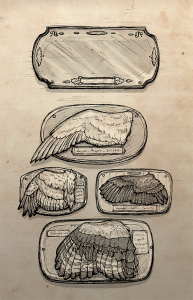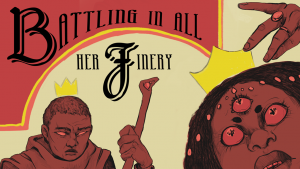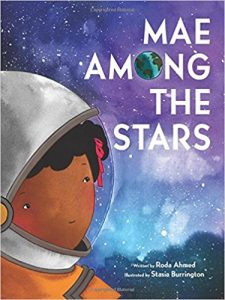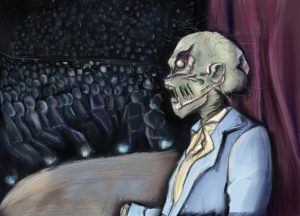An essay by Max Jamison, as provided by J. A. Psoras
Art by Luke Spooner
“In art the hand can never execute anything higher than the heart can inspire.”
– Ralph Waldo Emerson
I didn’t see it that way, but I was charmed. Fame. Fortune. Lot and lots of women. An assortment–colorful and convenient. Like fruity popsicles. As icy and sticky, too. No matter. Popsicles don’t hang around very long once you get your mouth on one.
Everything was at my fingertips.
That’s actually funny. If you could see me now.
You’d probably recognize my name. If not, you’d know my work. At least one of the film adaptations. Early on, the 3-D cartoons. Later, the “blockbuster interactive experience.”
I assumed a pseudonym so that no one could accuse me of riding my illustrious uncle’s coattails. But I didn’t even admit that much to myself.
My agent said that I had my uncle’s hands. I was such a prick that I found that insulting. Made me resent having to give Derek Meyers fifteen percent of my cut all the more. That Meyers … squealed like a freshman in heat each time he called me with the latest seven-figure deal he negotiated for “the nephew of the great–”
Even now, I won’t admit it.
Meyers was star-struck by me. My talent–that’s what I told myself. They all were. The cookie du jour by my side. My entourage. The eager devoted fans.
Why shouldn’t they have been? I was way more famous and inventive than any forerunner. Regarded. Well, who cares about regard? I found the nobody critics’ trite comparisons nothing more than boring. My uncle never had his name associated with an entire “camp” or “team.”
Don’t get me wrong. Deep-down, I admired my uncle. It was noble of him to try to prepare me for celebrity. The temptations–the distractions. He warned me how fickle it all could be. He warned me about a lot of things. Not excluding the seductive nature of technology. To him it was all about the work, the work, the work. And I knew what he meant–no computerized tools, no philandering. He wore his puritan views like a badge.
When artists stopped creating graphic novels by hand, he was adamant that I learn the old-fashioned way. Penciling, inking, painting. He wasn’t crazy about my over-the-top, “depraved” characters. The nudity. The swearing. He did praise my creativity, my “bold use of color and texture.” Just a didactic ruse-of-an afterthought; he was rendering me a boy with a crayon.
After I mastered the basics, I insisted that I learn it all. So he sent me to MIT–reluctantly–he was a stickler. Citing that “true skill is in the handwork.” Oh, and that “the human condition flows between the fingers and the heart.”
Whatever.
He was stuck in old ways. Limited within the constraints of two-dimensionality. I was an innovator. The first holographic novelist. Nobody else tapped into lenticular technology. The full range of motion, depth, and morphing. My stories fucking moved!

“Like I said before, you’ve got to get to work. I tried to make it easy. But you forced me to use my methods.”
To read the rest of this story, check out the Mad Scientist Journal: Winter 2018 collection.
Max Jamison is a world-renowned holographic novelist. His most successful book to date, The Midnight Hunter, was the first holographic novel of its kind. Jamison is credited with innovating the projected 3-D imagery closely associated with holographic novels. He is also credited with introducing additional sensory interactive components to holographic novels. Much of his work has been adapted to cartoon and feature-length films. Semi-retired, Jamison remains single, spending most of his time in Minnesota.
J. A. Psoras is earning a master’s in marriage and family therapy. Her fiction has been featured in Issue 160, Volume 16 of Aphelion. Another short story received an honorable mention in Allegory, Volume 16/43. Her urban fantasy novel, A Dark Corner, is available via Amazon.com. She lives in Philadelphia with her husband, a photojournalist.
Luke Spooner, a.k.a. ‘Carrion House,’ currently lives and works in the South of England. Having recently graduated from the University of Portsmouth with a first class degree, he is now a full time illustrator for just about any project that piques his interest. Despite regular forays into children’s books and fairy tales, his true love lies in anything macabre, melancholy, or dark in nature and essence. He believes that the job of putting someone else’s words into a visual form, to accompany and support their text, is a massive responsibility, as well as being something he truly treasures. You can visit his web site at www.carrionhouse.com.
“In Lieu of the Upper Hand” is Copyright 2017 J. A. Psoras
Art accompanying story is Copyright 2017 Luke Spooner

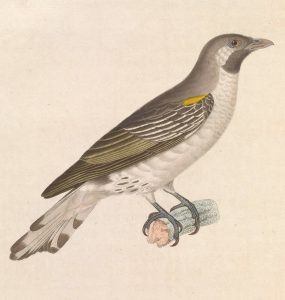
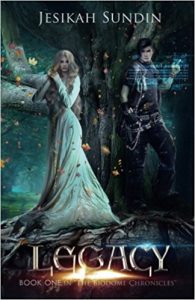 Legacy
Legacy